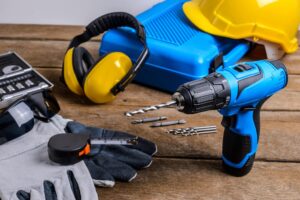Safety Rules for Power Tools Meeting Kit

WHAT’S AT STAKE
Portable power tools are divided into primary groups according to their power source, which are electrical, pneumatic, gasoline and hydraulic.
WHAT’S THE DANGER
POWER TOOL HAZARDS
- Hazards of exposure to repetitive vibration (repetitive strain injury).
- Inherent hazards of the power source.
Other Reasons for Power Tool Injuries
- Lack of experience when using the tool.
- Lack of training.
- Not paying attention while the machine is in motion.
- Design or manufacturing defects.
MOST COMMON POWER TOOL INJURIES
Electrical tools: Electric screwdrivers, drills, table saws, and other such equipment can cause injury by how quickly they move.
Hydraulic tools: In the case of a car jack, this can result in a car crashing down on whomever is below it.
Compressed air tools: Drills, woodchippers, and sanders are often powered by compressed air. The sheer pressure of using compressed air can result in hoses that are used to hook the equipment up flying off and hitting someone.
Gasoline or other fuel-powered tools: Saws that cut through concrete and chain saws are often powered by gasoline. Gasoline gives off dangerous fumes such as carbon monoxide and is combustible.
Abrasive tools: They use a wheel as part of a tool, which can result in debris hitting the eyes or other parts of the body.
HOW TO PROTECT YOURSELF
SAFETY RULES FOR ALL POWER TOOLS
1. Work Area
- Keep Work Areas Clean. Cluttered benches invite accidents.
- Avoid Dangerous Environments. Don’t use power tools in damp or wet locations.
- Keep Children Away. Do not let visitors come into contact with the tool or extension cord.
- Do Not Leave Tool Running Unattended. Do not leave tool until it comes to a complete stop.
- Do Not Operate Power Tools in Explosive Atmospheres. Power tools create sparks which ignite.
2. Personal Safety
- Guard Against Electric Shock. Prevent body contact with grounded surfaces.
- Dress Properly. Do not wear loose clothing or jewelry. Wear protective hair covering to contain long hair.
- Use Safety Equipment. Wear safety goggles or glasses with side shields.
- Stay Alert & Use Common Sense. Do not operate tool when you are tired or under influence of drugs or alcohol.
- Remove Adjusting Keys and Wrenches. Form habit of checking to see that keys and adjusting wrenches are removed from tool before turning it on.
- Avoid Accidental Starting. Don’t carry plugged in tool with finger on switch.
- Don’t Overreach. Keep proper footing and balance at all times.
3. Tool Use and Care
- Do Not Force Tool. It will do the job better and safer at the rate for which it was designated.
- Use The Right Tool. Don’t force a small tool or attachment to do the job of a heavy-duty tool.
- Secure Work. Use clamps or a vise to hold work.
- Don’t Abuse Cord. Never carry a tool by the cord or yank it to disconnect from receptacle.
- Outdoor Extension Cords. Use only extension cords suitable for outdoor use and marked with suffix WA (for UL) or W (for CSA).
- Disconnect Tools. When not in use; before servicing; when changing blades, bits, cutters, etc.
- Store Idle Tools. When not in use, tool should be stored in dry, high, or locked up place.
- Do Not Alter or Misuse Tool. Any alteration or modification not specified is misuse.
- Maintain Tools with Care. Keep tools sharp and clean for better and safer performance.
- Check Damaged Parts. A guard or other part that is damaged should be carefully checked to determine that it will operate properly.
POWER TOOLS: BEST PRACTICES
- Never carry a tool by the cord or hose.
- Never yank the cord or hose to disconnect it from the receptacle.
- Keep cords and hoses away from heat, oil, and sharp edges.
- Disconnect tools when not using them, before servicing and cleaning them, and when changing accessories such as blades, bits, and cutters.
- Keep all employees not involved with the work at a safe distance from the work area.
- Secure work with clamps or a vise, freeing both hands to operate the tool.
- Avoid accidental starting. Do not hold fingers on the switch button while carrying a plugged-in tool.
- Maintain tools with care; keep them sharp and clean for best performance.
- Follow instructions in the user’s manual for lubricating and changing accessories.
- Be sure to keep good footing and maintain good balance when operating power tools.
- Remove all damaged portable electric tools from use and tag them: “Do Not Use.”
FINAL WORD
Remember, always use the correct power tool for the task and take defective tools out of use for replacement or repair. Good use of power tools will increase productivity and improve safety.